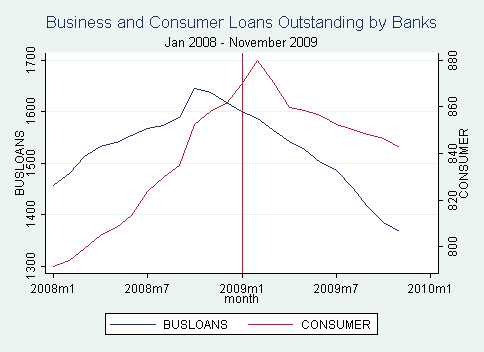So what are banks for, anyway?
This is a post which I originally published at New Deal 2.0.
Ed mentioned yesterday in his post Credit crises, market equilibrium, economic policy and fiat currencies that both the neoclassicals and the Obama Administration believe the financial crisis has been some sort of temporary liquidity crisis; fix the financial plumbing and it’s business as usual again. They just differ on who the plumber should be.
They are wrong and this post addresses why.
Sometimes a picture says it best. This graph from our colleagues at Angry Bear is introduced with the caption: What was the job of banks in 2009?
This chart tells me that the whole notion of Obama’s approach to the banks is fundamentally flawed. The Administration has operated on the assumption that the financial crisis is no more serious than some clogged plumbing — a bit of Draino in the form of government handouts and guarantees should be sufficient to get credit flowing again. Second, most major banks are not insolvent but rather have a temporary liquidity problem induced by malfunctioning financial markets. Time will allow market mechanisms to restore the true, higher, value of “legacy” assets. Once the banks are healthy, the economy will recover.
Well, this chart tells me that these premises are totally wrong. Many financial institutions are probably insolvent and need to be closed; assets must be analyzed carefully to figure out their profitability potential and the true financial state of financial institutions; an investigation must be open to determine responsibility among top managers. Even though financial markets have stabilized, they are still under heavy assistance by the government and we have not dealt with the solvency problems. Banks have been posting profit but, gains largely come from exceptional cash inflows (e.g., the sale of Smith Barney by Citi), they still need large government help to make those profits (Goldman Sachs repaid $10 billion of CPP money to avoid the executive pay limit, but still got $12.9 billion from the help provided to AIG, and suspicions of accounting manipulation (if not fraud) are surrounding the valuation of assets.
Provide funds to borrowers to help them service their loans and become more creditworthy. Obviously, with the economy still in dismal shape, borrowers are still stressed, making banks less inclined to extend credit. By the same token, the banks themselves are still in a perilous condition for the most part, so they feel the need to hoard cash, rather than extend credit. When you do that, the chart will turn back up because banks lend when they perceive creditworthy borrowers. It’s that simple. Tragically, the “experts” running Obama’s economic policy, and the President himself, don’t get it.

Comments are closed.